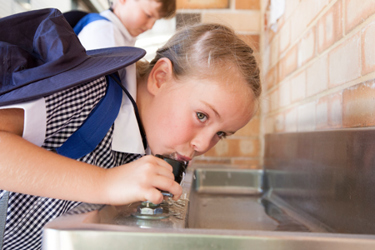New School Of Thought On Reducing Lead Exposure For Children
By Jonathan Cuppett

The EPA wants water authorities to help schools and childcare centers get the lead out of drinking water, but what resources are available to help water authorities?
Concerning the (LCRR), the U.S. EPA is leveling particular attention on schools and childcare centers. The effects of lead ingestion include reduced IQ and attention span, Lead and Copper Rule Revisions learning disabilities, poor classroom performance, hyperactivity, behavioral problems, impaired growth, and hearing loss, effects that are especially pronounced in young children and occur at much lower lead exposure levels than they do in adults.
Therefore, the LCRR has focused on places where children are likely to consume tap water and where they spend a significant portion of their young lives. Even when water systems are meeting all federal and state health standards regarding lead, older schools and childcare centers may have aged plumbing materials that can contribute to lead in drinking water.
While some states already require schools to test for lead in drinking water, not all of them do. Community water systems are typically the local water authorities on clean drinking water, so they have been tasked by the EPA to close the gap in helping centers for early childhood education start the process for ensuring that children in their care are not exposed to lead in their drinking water. This has resulted in certain requirements for how community water systems must engage with elementary schools and childcare facilities.
Requirements Of The LCRR That Are Not Going To Change
The EPA finalized the LCRR1 in January of 2021 and announced that a new rulemaking, Lead and Copper Rule Improvements (LCRI), would be issued before the compliance deadline of Oct. 16, 2024, which could make material modifications to the LCRR. This arrangement has put many community water systems in limbo, as they are hesitant to take action and spend resources prematurely.
However, there is one condition of the LCRR that the EPA has said will not change: Community water systems must have developed and submitted a Lead Service Line Inventory by the 2024 compliance deadline.
Everything else that follows in this article, including the school and childcare requirements,2 is subject to change with the release of the LCRI. Currently, providers must submit a finalized list of every school and childcare center served by a water network by the 2024 deadline. Water systems will likely need to work with their state’s department of education as well as consulting their own records to compile this list.
While we don’t yet know what will change, every indicator is that the changes will be more, not less, stringent than what has already been published. What follows is an overview of what water utilities should expect regarding their responsibilities to schools and childcare centers.
Requirements Begin With Communication
Beginning in 2025, community water systems will be required to communicate the following to all elementary and childcare facilities that it serves:
- An annual overview of the health risks of lead exposure in children
- Notification that the water system is required to sample for lead at elementary schools and childcare facilities
- A proposed schedule for sampling at the facility
- Information about sampling for lead in schools and childcare facilities.
A helpful resource for rolling out these four steps is the 3Ts for Reducing Lead in Drinking Water,3 a publication from the EPA. While this publication is designed for schools and childcare facilities, it contains language and guidance that community water systems will find helpful as they embark on working with schools and childcare centers.
Community water systems also must contact the secondary schools (high schools) identified in the list annually and provide them with health information, information on how to request sampling, and information about sampling for lead in schools and childcare facilities. The difference for high schools is that testing must be offered but is not mandatory.
Schools and childcare facilities will be exempt from testing if they were built after Jan. 1, 2014, or after the date that their state implemented the Reduction of Lead in Drinking Water Act standards — whichever is earlier. Community water systems also are not required to test schools or childcare facilities that are themselves regulated as a public water system, as those are classified as “Non Transient Non Community Water Systems” and are directly subject to all LCRR requirements.
The Lowdown On Sampling
Beginning in 2025, community water systems must conduct sampling in at least 20% of elementary schools (typically K–eighth grade) and childcare facilities each year, and continue for five years until all elementary schools and childcare facilities have been sampled. (Again, those built after Jan. 1, 2014, are exempt.) An alternative schedule can be approved by the state, as long as all elementary schools and childcare facilities are sampled once within a five-year period. Schools that refuse or do not respond may be accounted for in the 20% testing rate with proper documentation. Community water systems are not required to sample any individual school or childcare facility more than once every five years.
At least 30 days prior to sampling, the water system must provide instructions to facilities on how to identify outlets for sampling.
Five samples are required for schools, and two samples are required for childcare facilities at outlets typically used for consumption. For schools, these typically include two drinking water fountains, one kitchen faucet used for food or drink preparation, one classroom faucet or other outlet used for drinking, and one nurse’s office faucet, as available. For childcare facilities, these typically include one drinking water fountain and either a kitchen faucet used for preparation of food or drink or one classroom faucet or other outlet used for drinking.
If any facility has fewer than the required number of outlets, the water system must sample all outlets used for consumption. If any facility does not contain the type of faucet listed above, the water system shall collect a sample from another outlet typically used for consumption, as identified by the facility.
Samples from the cold water tap must follow these requirements:
- Each sample for lead shall be a first draw sample of water that has been stationary (untapped) in the plumbing system of the sampling site (building) for at least eight but no more than 18 hours.
- The sample must be 250 ml in volume.
- The water system, school, or childcare facility, or other appropriately trained individual, may collect samples.
Beginning in 2025, secondary schools (high schools, or grades nine-12), as well as elementary schools and childcare facilities, must be sampled upon request. If a water system conducts tests at more than 20% of the schools/childcare facilities it serves during a year, it may defer additional requests to the following year.
Notification Of Results And Waivers
A water system must provide analytical results to the school or childcare facility no later than 30 days after receipt of the results, along with information about remediation options (if lead is detected). The water system also must provide analytical results annually to the local and state health departments, as well as the state regulator if different from those listed previously.
During the cycle of mandatory sampling in elementary schools and childcare facilities, a state may issue a written waiver to a community water system if there is already a state or local program to sample for lead in drinking water at schools or childcare facilities that meets the requirements of this rule. This also may include schools or childcare facilities that are sampling for lead through a facility’s or district’s policy if the sampling meets the final rule requirements. Waivers may also be included in other circumstances depending on the requirements of the existing/current program. However, sampling conducted at schools or childcare facilities prior to 2025 does not qualify for a waiver. When a community water system has completed the requirements for all elementary schools and childcare facilities once, the EPA requires the system to sample elementary and secondary schools and childcare facilities upon request.
What Happens If Lead Is Detected?
While strongly encouraged by the EPA, communication to parents, staff, and other stakeholders, as well as remediation, are voluntary and up to the school or childcare facility. The community water system is required only to provide remediation options as provided in 3Ts for Reducing Lead in Drinking Water, a publication that also outlines easy-to-follow suggestions for communicating with stakeholders.
Possible remediation options include:
- Disconnect or replace problem outlets
- Post “Not for Drinking/Cooking” at problem outlets
- Flush taps prior to use
- Provide bottled water
- Install filters on problem outlets
- Replace or bypass old plumbing pipes and fixtures.
Following remediation efforts, schools and childcare facilities should be encouraged to engage in follow-up testing to ensure that lead is no longer present.
The Bad News: The Cost And Administrative Burden Of Testing Are High
According to the American Public Works Association (APWA), approximately 85% of water utilities have three or fewer employees, so adding school and childcare facility testing to their overfull to-do list is daunting. Likewise, school administrators already juggle an impossible load and may wonder where they will find the time to undergo training, participate in the testing, and oversee mitigation, if indicated.
Furthermore, the cost per facility for sampling, analyzing, remediating, and supporting programming is estimated to be thousands of dollars or more depending on what remediation actions are taken. When multiplied across a district, the numbers can quickly add up.
The Good News: Expert Help And Funds Are Available
Many community water systems are enlisting the help of LCRR experts to manage the process of working with schools and childcare facilities. Private companies like 120Water can provide exceptional efficiency and cost-effectiveness in overseeing communication with schools and childcare facilities, scheduling and executing initial sampling, and follow-up sampling and stakeholder communication, ensuring that community water systems are successfully meeting the established deadlines for testing at all eligible facilities in their service jurisdiction. As of March 2023, the company had taken nearly 200,000 samples at over 3,500 schools and childcare facilities.
In the infrastructure bill passed in 2021, Congress earmarked $15 billion to replace lead pipes and $200 million for lead testing and remediation in schools. As this money trickles into state funds, water systems should take advantage of unprecedented funding opportunities to fulfill the EPA’s new lead and copper rule requirements and ensure safe drinking water for our nation’s children.
References:
- https://doh.wa.gov/community-and-environment/drinking-water/contaminants/lead/lead-and-copper-rule-revisions
- https://www.cdmsmith.com/en/Client-Solutions/Insights/Sampling-for-Leadat-Schools-and-Child-Care-Centers
- https://www.epa.gov/ground-water-and-drinking-water/3ts-reducing-leaddrinking-water
 About The Author
About The Author
Jonathan Cuppett is the director of water quality compliance at 120Water.
